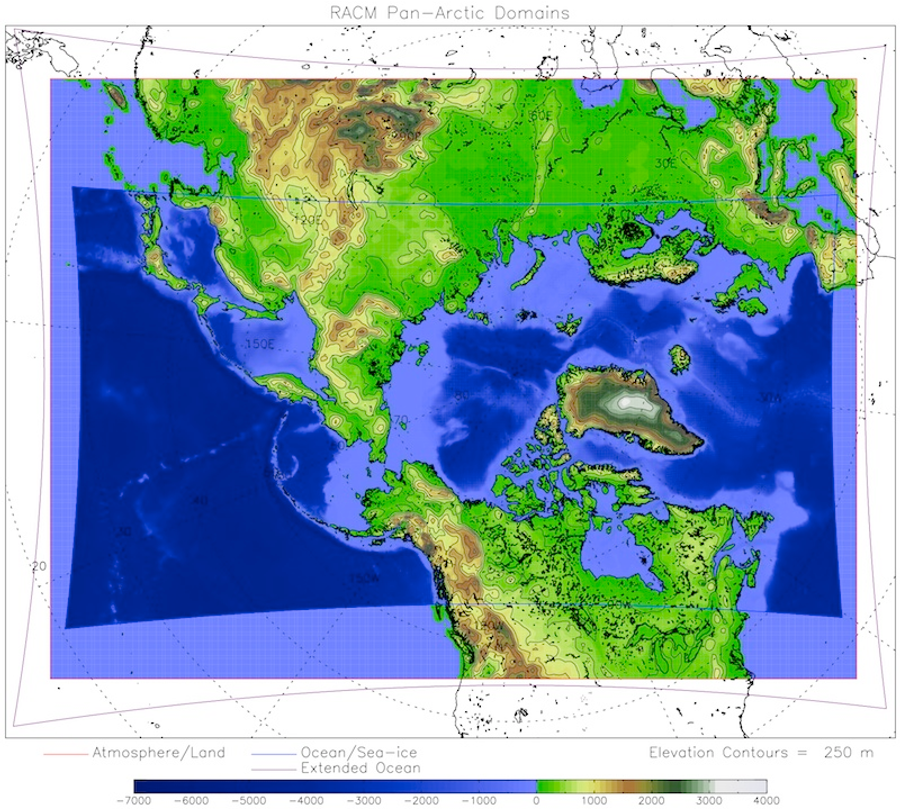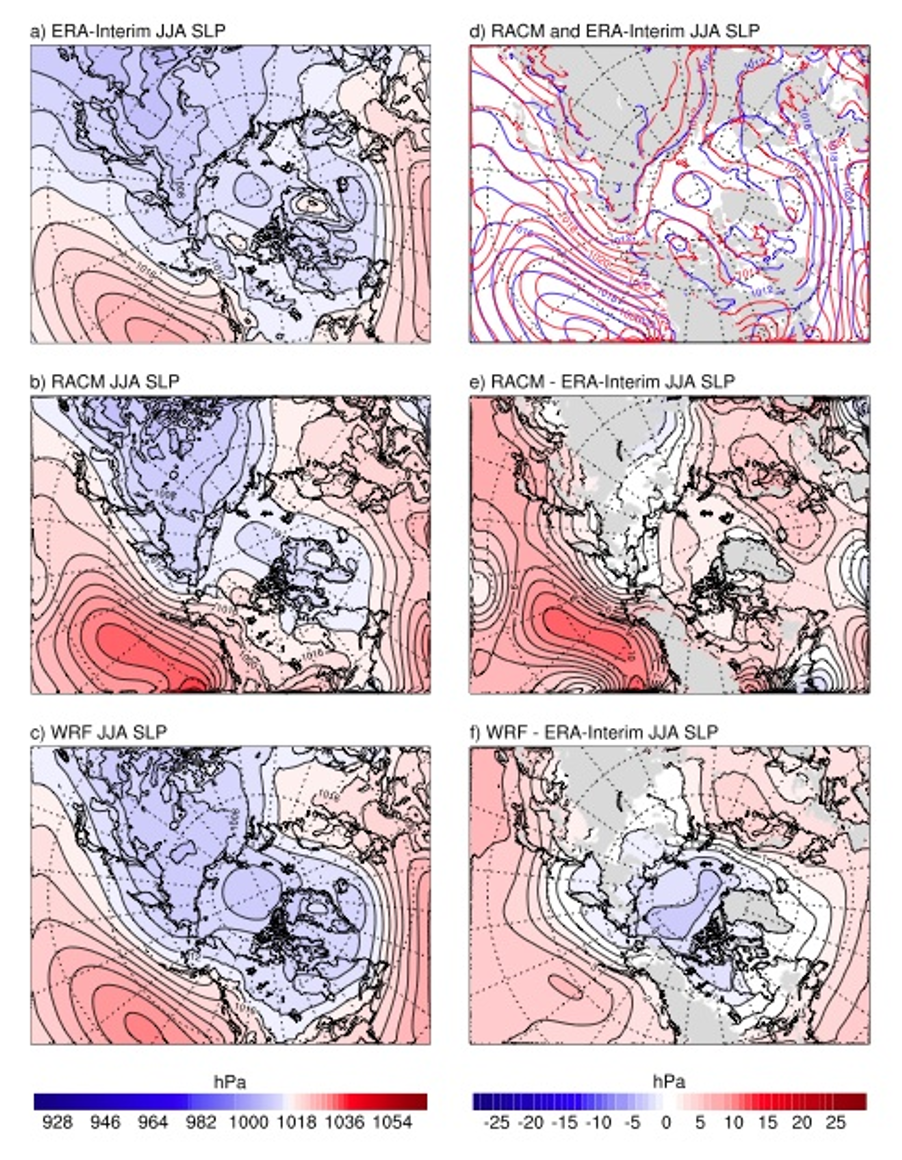
Final Technical Report
DE-FG02-07ER64462
Collaborative Research: Towards Advanced Understanding
and Predictive Capability of Climate Change in the Arctic
Using a High-Resolution Regional Arctic Climate System Model
August 2007 to August 2012
Research Activities
Development of the fully coupled RACM
The primary research task completed for this project was the development of the
Regional Arctic Climate Model (RACM). This involved coupling existing atmosphere,
ocean, sea ice, and land models using the National Center for Atmospheric Research
(NCAR) Community Climate System Model (CCSM) coupler (CPL7). RACM is based on
the Weather Research and Forecasting (WRF) atmospheric model, the Parallel Ocean
Program (POP) ocean model, the CICE sea ice model, and the Variable Infiltration
Capacity (VIC) land model. All partner institutions (University of Colorado, Naval
Postgraduate School, Iowa State University, and University of Washington) as well as
scientists at the University of Alaska – Fairbanks International Arctic Research Center
(IARC) and Arctic Region Supercomputing Center (ARSC) assisted with this activity.
The atmospheric portion of RACM development included modification of WRF to allow
communication with CPL7 and the other RACM component models. Extensive testing
and debugging of the coupled model occupied much of our effort over the duration of
this project. At the end of the project the fully coupled atmosphere – ocean – sea ice –
land model was able to run stably for decadal length simulations although some biases
in the model climate still existed.
The version of RACM developed as part of this project was configured to run on a large
pan-Arctic model domain (Figure 1) that included all sea ice covered waters in the
Northern Hemisphere and all Arctic Ocean draining watersheds. WRF and VIC use a 50
km horizontal grid and POP and CICE use a ~9 km horizontal grid.
Evaluation of decadal fully coupled RACM simulations, and comparison with comparable
stand-alone WRF simulations, indicates that atmospheric biases are similar in
magnitude to those found in WRF-only simulations. Simulation of the annual evolution of
sea ice is reasonable, with some biases related to biases in the WRF simulations. We
found that the RACM simulation of circulation (Figures 3 and 4) and precipitation is
comparable to stand-alone WRF. Near surface temperatures are better simulated over
the Arctic Ocean in RACM as a result of a more realistic time evolving sea ice state
compared to the simplified specified sea ice state in stand-alone WRF (Figure 5). Near
surface temperatures over the high latitude land areas of the pan-Arctic model domain
showed larger biases in RACM compared to WRF (Figure 5). The source of this
increased land surface temperature bias was eventually identified as a model error
related to strong static stability during the winter over land areas and was corrected after
the end of this award. A manuscript (Higgins et al. 2012) describing the atmospheric
climate in RACM was submitted before the end of this project but was subsequently

withdrawn after several errors in the model were identified. This manuscript is being re-
written as part of our continuing RACM / RASM effort funded by DOE.
The primary outcomes from the development of RACM include:
- RACM is stable and produces a reasonable climate for decade length simulations
- the atmospheric state simulated by RACM is comparable to that simulated in stand-
alone WRF. This is a very positive result given the increased degrees of freedom in the
coupled model compared to the stand-alone WRF and provides confidence that the
basic model coupling that was completed as part of this project is correct.
- Some aspects of the RACM simulation exhibit improvement compared to stand-alone
WRF due to the inclusion of more realistic coupled physical processes. The clearest
example of this is in the near surface temperature over the Arctic Ocean where fine
scale representation of leads and varying ice thickness allow for more realistic energy
transfer from the ocean to the atmosphere and results in a removal of the stand-alone
WRF Arctic Ocean near surface cold bias.
Evaluation of stand-alone WRF simulations
A secondary research task for this project was testing and evaluation of WRF for
climate-scale simulations on the large pan-Arctic model domain (Figure 1) used in
RACM. This involved identification of a preferred set of model physical
parameterizations for use in our coupled RACM simulations and documenting any
atmospheric biases present in RACM. This work led to the publication of Cassano et al.
(2011). The Polar Meteorology Group at the Byrd Polar Research Institute at Ohio State
University assisted with this effort and were supported on this project with a sub-contract
from the University of Colorado. The research efforts at Ohio State University led to
publication of Bromwich et al. (2009) and Hines and Bromwich (2008).
Evaluation of stand-alone WRF simulations relied on observational data from the
Surface Heat Budget of the Arctic (SHEBA) field campaign, data from the Barrow
Department of Energy (DOE) Atmospheric Radiation Measurement (ARM) site, and
observations from the International Systems for Observing the Atmosphere (IASOA)
sites as well as global reanalysis data. The WRF simulations were designed to evaluate
radiation and cloud microphysics parameterizations and tested 30 different physics
combinations. It was found that many of the physics combinations produced similar
results, although some physics combinations were clearly not appropriate for use in the
Arctic. Our conclusion from these simulations was that the CAM shortwave and
longwave radiation parameterizations perform best in the Arctic environment and were
selected as the radiation parameterizations for RACM.
Based on the stand-alone WRF simulations completed as part of this project we were
able to identify a preferred set of WRF physical parameterizations for use in climate-
scale pan-Arctic simulations with WRF and RACM as described in Cassano et al. (2011).
We also identified significant circulation biases in WRF when run on a large pan-Arctic
model domain, that were related to model errors that accumulate at the model top
boundary. It was found that the use of spectral nudging in the top half of the WRF model

domain can eliminate these circulation biases (Figure 2). Therefore, all fully coupled
RACM simulations use the WRF spectral nudging option.
As part of the stand-alone WRF testing two WRF simulations on the pan-Arctic model
domain were completed. These simulations covered the time period 1989 to 2009 and
output from these simulations will be provided to the Coordinated Regional Downscaling
Experiment (CORDEX) data archive. One simulation was run with prescribed lateral
boundary conditions, provided by the ERA-Interim reanalysis, while the second used the
same lateral boundary conditions as well as spectral nudging in the upper half of the
model domain to further constrain the model.
Related research activities
Research activities related to the primary RACM development and WRF evaluation led
to two publications. These papers include an analysis of land surface response to
reduced Arctic sea ice (Higgins and Cassano 2011) and an analysis of Arctic
atmospheric circulation regimes (Fisel et al. 2011).

Publications
Bromwich, D.H., K.M. Hines, and L.-S. Bai, 2009: Development and Testing of Polar
Weather Research and Forecasting Model: 2. Arctic Ocean. J. Geophys. Res.,
114, D08122, doi:10.1029/2008JD010300.
Cassano, J.J., M.E. Higgins, and M.W. Seefeldt, 2011: Performance of the Weather
Research and Forecasting (WRF) Model for Month-long pan-Arctic Simulations.
Mon. Wea. Rev., 139, 3469-3488, doi:10.1175/MWR-D-10-05065.1.
Fisel, B.J., W.J. Gutowski Jr., J.M. Hobbs, and J.J. Cassano, 2011: Multi-regime states
of the Arctic atmospheric circulation. J. Geophys. Res., 116, D20122,
doi:10.1029/2011JD015790.
Higgins, M.E. and J.J. Cassano, 2011: Northern Alaskan land surface response to
reduced Arctic sea ice extent. Clim Dyn., in press, DOI 10.1007/s00382-011-
1095-0.
Higgins, M.E., J. He, J.J. Cassano, A. Craig, W. Gutowski, J. Jakacki, D.P. Lettenmaier,
W. Maslowski, A. Roberts, and C. Zhu, 2012: The Regional Arctic Climate Model
(RACM): Atmospheric implementation and validation. J. Clim., withdrawn.
Hines, K.M., and D.H. Bromwich, 2008: Development and testing of Polar WRF. Part I.
Greenland ice sheet meteorology. Mon. Wea. Rev., 136, 1971-1989.

Meetings Attended / Presentations
Year 1: August 2007 – May 2008
Attend DOE Climate Change Prediction Program Science Team meeting, Sept 2007
Poster presentation: Maslowski, W., J. Cassano, W. Gutowski, and D. Lettenmaier,
Towards Advanced Understanding and Predictive Capability of Climate Change in
the Arctic Using a High-Resolution Regional Arctic Climate System Model (RACM) –
New Project Overview
Meet with project co-PI Dennis Lettenmaier, Seattle, WA, Oct 2007
Attend SEARCH for DAMOCLES workshop, Paris, France, Oct 2007
Oral presentation: Cassano, J.J., Atmospheric Modeling in an Arctic System Model
Oral presentation: Bromwich, D.H., K.M. Hines, and J.J. Cassano, Polar Optimized WRF
American Geophysical Union fall meeting, San Francisco, CA, Dec 2007
Poster presentation: Roberts, A., J. Hutchings, W.D. Hibler III, and M. Seefeldt,
Atmospheric and Oceanic Forcing of Sea Ice Drift and Deformation During the
SEDNA Field Campaign
Attend project meeting with all project PIs, San Francisco, CA, Dec 2008
Attend Little Alaska Weather Symposium, Fairbanks, AK, May 2008
Invited oral presentation: Cassano, J.J., M.W. Seefeldt, and E.N. Cassano,
Development and Evaluation of Polar WRF
Attend project meeting with all project PIs, Boulder, CO, May 2008
Year 2: June 2008 – May 2009
Attend Antarctic Meteorological Observation, Modeling and Forecasting Workshop,
Madison, WI, June 2008
Oral presentation: Cassano, J.J. and M.W. Seefeldt: Development and evaluation
of Polar WRF.
Attend WRF Users’ workshop, Boulder, CO, June 2008
Poster presentation: Seefeldt, M.W., and J.J. Cassano: Evaluation of long duration
WRF simulation in the Arctic.
Oral presentation: Seefeldt, M.W. and J.J. Cassano: An overview of the regional
Arctic Climate System Model (RACM)
Attend project collaborative meeting, Ames, IA, September 2008




